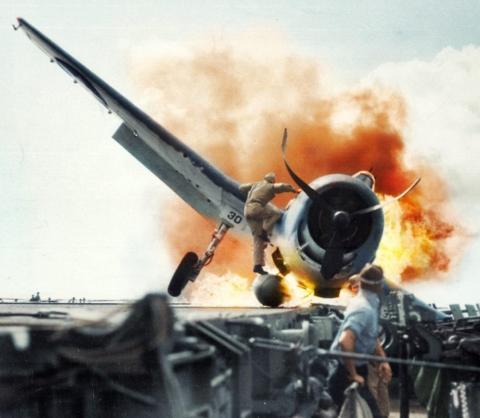CHEWNING-WALTER
WALTER LEWIS CHEWNING JR.

LCDR

RECIPIENT OF NAVY AND MARINE CORPS MEDAL
On November 10, 1943, Ensign Byron Milton Johnson, departed Barber’s Point, Hawaii, with a flight of Hellcat F6F-3 fighters of VF-2 for a routine exercise to join the carrier USS Enterprise (CV-6) at sea. Upon approaching Enterprise, the Hellcat developed engine trouble and Johnson requested an emergency landing. He was waved off three times as he struggled to maintain control and on the third pass the Hellcat inadvertently caught the third arresting gear wire and Johnson’s Hellcat was slammed into the deck, coming to rest in the port catwalk. The crash crushed the external belly fuel tank and leaking gasoline was ignited by sparks from the propeller which bent itself on the deck. The hard landing also jammed the closed canopy, shearing the retaining pin and Johnson was unable to force the canopy open.
Lieutenant Walter Lewis Chewning, the Enterprise catapult officer, seeing Johnson’s plight, sprinted from the catwalk and climbed on top of the burning belly tank as he forced open the canopy and pulled Johnson to safety. Chewning reached the burning aircraft well before the fire fighting crew who reportedly was hesitant to approach the burning aircraft as it carried live ammunition. In view of the incredible bravery exhibited by Chewning in rescuing Johnson who received only slight injuries, Chewning was awarded the Navy and Marine Corps Medal. A photograph of Chewning standing on the belly tank of the burning aircraft has become an iconic picture of World War II. Because of wartime censorship, the picture was not made public until January 1945 and has been used hundreds of times since then. The photograph reportedly ranks 23rd among the 100 greatest military photographs ever taken.
Chewning was born February 19, 1914, in Philadelphia, Pennsylvania. He reportedly attended Cornell University where he played soccer and lacrosse while studying mechanical engineering. Following graduation in 1936 he studied at the Massachusetts Institute of Technology before joining the Navy in January 1941. He was assigned as assistant to the chief engineer at the Naval Aircraft Factory in Philadelphia before being assigned to the Enterprise where he was the catapult officer until December 1944. He was next assigned to the Naval Air Station, Dutch Harbor, Alaska, where he served until leaving the Navy in December 1949. After World War II, Chewning assisted in research and development for several aeronautical companies, the U.S. Air Force, and the fledgling National Aeronautics and Space Administration. He died on February 4, 1990, and is buried at Green Valley Cemetery in Sahuarita, Arizona.
Submitted by CDR Roy A. Mosteller, USNR (Ret)


